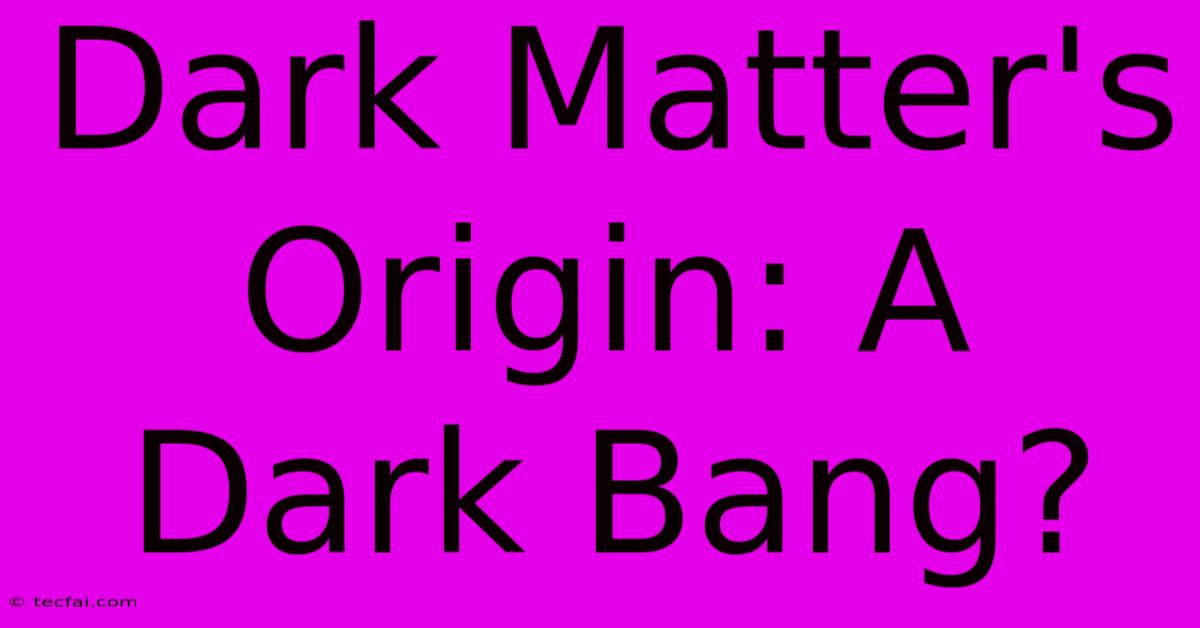Dark Matter's Origin: A Dark Bang?

Discover more detailed and exciting information on our website. Click the link below to start your adventure: Visit Best Website tecfai.com. Don't miss out!
Table of Contents
Dark Matter's Origin: A Dark Bang?
The universe, as we observe it, is a perplexing place. Visible matter – stars, planets, galaxies – only accounts for a tiny fraction of its total mass-energy. The vast majority is attributed to mysterious substances we can't see: dark matter and dark energy. While dark energy's nature remains even more elusive, scientists are actively investigating the origins of dark matter, and a fascinating hypothesis has emerged: the "dark bang." This article delves into this intriguing theory and the current state of research.
The Enigma of Dark Matter
Before exploring the "dark bang," let's establish the fundamental mystery. Dark matter's existence is inferred through its gravitational effects on visible matter. Galaxies rotate faster than they should based on the visible mass alone, and gravitational lensing – the bending of light around massive objects – reveals far more mass than we can see. This "missing mass" is attributed to dark matter, an unknown substance that interacts weakly, if at all, with light.
What We Know (and Don't Know)
We know dark matter exists due to its gravitational influence. However, its composition remains a profound enigma. Leading candidates include Weakly Interacting Massive Particles (WIMPs) and axions, hypothetical particles predicted by various theoretical models. But decades of searching have yet to yield definitive proof of their existence.
The "Dark Bang" Hypothesis: A Parallel Creation
The "dark bang" theory proposes that dark matter didn't emerge from the Big Bang in the same way as ordinary matter. Instead, it suggests a separate, parallel "dark sector" underwent its own Big Bang-like event – a dark bang – potentially at a different time and with different physical laws. This independent creation event could explain the abundance of dark matter in the universe and its apparent decoupling from ordinary matter.
Implications and Predictions
This hypothesis has significant implications:
- Different physics: A dark bang implies physics different from those governing our visible universe. The laws governing the dark sector could be vastly different, leading to unique interactions and particle types.
- Asymmetric creation: The different expansion rates and conditions between the two sectors could explain the observed asymmetry between dark matter and ordinary matter in the universe. The dark bang might have produced a vastly larger amount of dark matter than ordinary matter.
- Observable consequences: The interaction, however weak, between the dark and visible sectors could lead to observable signatures. For instance, subtle anomalies in cosmic microwave background radiation could potentially reveal clues.
Testing the "Dark Bang" Theory
Currently, the "dark bang" is a theoretical concept. However, ongoing and future research could provide crucial tests:
- Advanced particle detectors: More sensitive experiments searching for WIMPs and axions could indirectly support or refute the theory. The detection of such particles could provide insights into the possible characteristics of the "dark sector."
- Cosmic microwave background analysis: Precise measurements of the CMB could reveal subtle anisotropies or anomalies that might indicate an interaction between the dark and visible sectors.
- Gravitational wave detection: If the dark bang generated gravitational waves, their detection could provide strong evidence supporting the theory.
Conclusion: A Frontier of Discovery
The "dark bang" hypothesis presents a radical, yet compelling, explanation for the origin of dark matter. It highlights the immense unknowns in cosmology and the potential for entirely new physics beyond our current understanding. While still a theoretical possibility, the idea stimulates further investigation and directs research towards new avenues for exploring the universe's most profound mysteries. Future experiments and observations will be crucial in determining the validity of this intriguing – and potentially revolutionary – idea.

Thank you for visiting our website wich cover about Dark Matter's Origin: A Dark Bang?. We hope the information provided has been useful to you. Feel free to contact us if you have any questions or need further assistance. See you next time and dont miss to bookmark.
Featured Posts
-
Prairie Sees Strong Small Business Saturday
Dec 01, 2024
-
Flick On Barcas Las Palmas Setback
Dec 01, 2024
-
Cricket World Mourns Test Star
Dec 01, 2024
-
Amakhosi Se Polokwane Program
Dec 01, 2024
-
Las Palmas Upsets Barcelona
Dec 01, 2024
